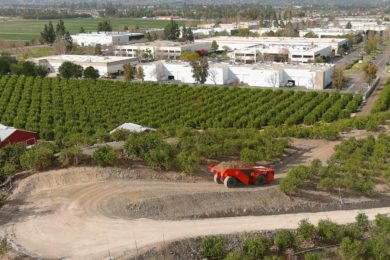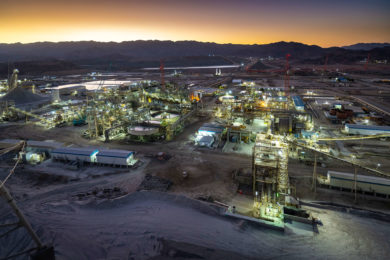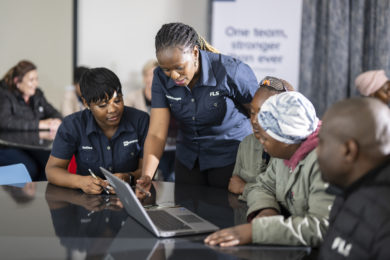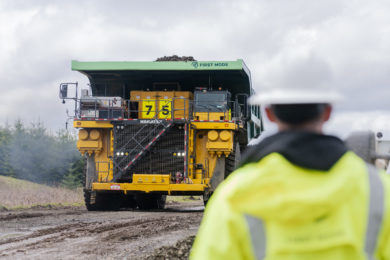At MINExpo 2021, IM Editorial Director Paul Moore sat down with Ville Laine, the Vice President of Sandvik Mining and Rock Solutions’ new BHEV business unit, to find out about the company’s battery electric journey so far, the bringing together of Artisan and Sandvik, new investment, the customer experience and plans for the future
When Sandvik bought Artisan each company had their own ongoing BEV products and R&D – how have the two companies now come together under the new Sandvik battery and hybrid electric vehicle (BHEV) business unit that you now head up?
Of course we had the history of both electric and diesel machines from Sandvik and the novel BEV technology from Artisan – and now we are just combining all these strengths together, which can be seen in the new Sandvik TH550B truck at MINExpo 2021 and on the soon to be launched Sandvik TH665B. The Sandvik LH518B was the first machine to be fully jointly developed, which has a lot of commonality between the Artisan series machines and Sandvik’s loader design. We are further refining the designs all the time – whenever we have a new product from now on we are making sure it has the best of both. The coming together of Sandvik and Artisan has been a major success, not only on the technical side on how the machine works, but also in being able to bring the well proven Sandvik loader development and design philosophy – Sandvik LHDs don’t just push into the muckpile as an example, we use hydraulics combined with smart geometry to enable the use of both lift and tilt functions simultaneously when penetrating the blasted rock to allow efficient one pass bucket filling.
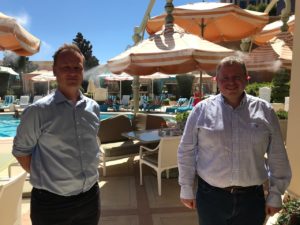
Ville Laine, Vice President of Sandvik Mining and Rock Solutions’ new BHEV business unit; and IM Editorial Director, Paul Moore
Will the previously Artisan branded models now be altered to bring them into line with the new joint design approach?
The Artisan name will not disappear because despite being a young brand it is already very famous as being a pioneer in underground mining development. We will maintain the use of the Artisan™ brand for the battery pack and electric driveline. It will also be visible on those parts of the machine. But it will not be part of the main machine naming going forward. As we have done with the Z50 evolving into Sandvik TH550B – this process will now also take place with some of the remaining Artisan branded models including loaders changing from ‘A’ machines to Sandvik ‘LH’ machines. It will just reflect the fact that the machines have had changes bringing them into the Sandvik electrification roadmap and fit with the rest of the Sandvik product line-up. Look at the Sandvik LH518B – the battery powertrain is based on Artisan technology but on the machine itself – you will see a lot of design similarities to our highly successful Toro LH517i, for example. And it goes beyond that in terms of the boom, hydraulics and many other areas.
Will there be two main centres for the BHEV business unit, namely Turku, Finland and Camarillo, California?
Yes, we have two hubs – BEV manufacturing will be shared between both sites based on supplying global demand, but Camarillo is now our main BHEV innovation centre. I would best describe it that we are building on our complementary strengths, after the machine has been initially developed in Camarillo then Turku carries out further product development and enhancement of the design, taking onboard Sandvik’s vast experience at the Turku factory including all the data from mines around the world operating Sandvik machines, as well as working together with Camarillo on new concepts and rapid prototyping. Plus Turku heads up our hybrid diesel-electric product development. Before acquiring Artisan we had supplied hundreds of Sandvik tethered units already but have now a combination of technologies including these along with diesel-electric hybrid, diesel and of course the fully battery machines to bring the most comprehensive offer in the industry to our customers. Whatever it is, it is now Sandvik.
What is the latest on the AutoMine® Concept autonomous battery loader?
We’ve operated it extensively at our test mine in Tampere, Finland, and it will continue to serve as a rapid prototype test machine, from which we will develop new technologies and introduce these features as a part of our commercial offering for AutoMine. We are constantly refining it.
What about ramping up tests and rollouts of the main BEV product line?
You have already published many of the test programs or fulfilled orders we have running with Barrick, Kirkland Lake Gold, Pretivm and Sibanye-Stillwater in North America plus the battery units now operating at New Afton and set to go to Fosterville in Australia as well as the machines set to be trialled at Kennecott Utah Copper. In addition, we have a Z50 and Sandvik LH518B going to Gold Fields’ St Ives operation as well as other 50 t class trucks including Sandvik TH550B set for tests in Australia. And next year will see another Sandvik LH518B going to South Africa for testing. So there is a lot ongoing and a lot of advanced discussions.
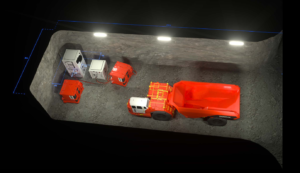
Has there been much customer feedback on the machines already out there?
Yes and to focus on one machine, the 18 t loader has got a really positive response on both the machine performance, including its quiet operation and powerful torque, but also the ergonomics of the operator cabin and the operator access to machine data. Overall, the same types of digitalisation, intelligent control and service improvements we have made on the diesel line such as on Toro LH515i we are also applying across our new battery electric models.
What is happening as regards further development of electric development and production drills?
Of course, we already have our tethered electric drills such as Sandvik DD412iE as well as our new 400i series battery models including Sandvik DL422i longhole drill and Sandvik DS412iE bolter, which are not part of the BHEV business unit but are handled by our Underground Drills division headed by Pat Murphy. These models do use fixed charging while drilling as they are by application less mobile machines. However, there is also a lot of discussion ongoing between the two business units about commonality of approach with regard to batteries and potential use of battery swapping as well as common components and supply chain where possible.
Artisan had done a lot of the work on battery swapping – how has this process benefitted from Sandvik’s further development?
The fast swapping technology is patented and now referred to as Sandvik AutoSwap and is if anything even faster than it was before – we are now achieving around three minutes for Sandvik TH550B as opposed to fixed charging which requires up to 30 minutes. The same system is used for our loaders. And we continue to see this as the best option – for one thing it is not putting a lot of extra load on the mine’s power network so you don’t get a lot of peaks. That is not to say Sandvik is not open to other powering options but today this is where we see the future – battery swap and using lithium-iron phosphate LFP battery chemistry which we see as the safest and most fit for purpose and most reliable. It is also important to say that we make our own batteries – of course we buy battery cells but we make the battery packs.
How are you working to bring together your BEVs with the AutoMine automation system? How will the battery swap work with AutoMine?
With the exception of the AutoMine® Concept loader and Toro LH514BE we do not yet offer the battery machines with AutoMine, however, it is being done and will be available soon – and for certain BEV models, for new orders of battery machines going forward, AutoMine readiness and functionality will be included. We are working closely with the AutoMine team on this. On the battery change, AutoSwap already involves just a minimal amount of manual input and the process will be fully autonomous in the near future.
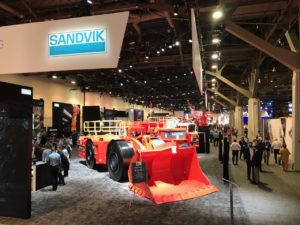
What other aspects are important to get right in BEV underground operation?
You can’t just focus on the machine – it is still a learning curve for everyone in the industry – so you need to build up the knowledge base and put in place training for the technicians and others at the minesite. And we have put training plans and trainers in place for that. It doesn’t have to be seen as a big, challenging step but it is still one that everyone has to take. As it is a developing market for all the new customers we have significant Sandvik teams onsite to help adjust to the BEVs with training as part of that. We have also taken most of these customers to our hub in Camarillo where we have a training centre and have set up a similar capability in Finland. At Camarillo we have our new test track which we also use to train operators. Actually for an experienced operator the move from diesel to BEV is not that difficult – the change is greater for technicians. The machines need far less maintenance than diesel machines, but they still need some maintenance. We are working on remote training and troubleshooting using AR and gaming type environments. But we have done everything we can to make the transition as trouble free as possible for customers – we like to say we rethink the machine so they don’t have to rethink the mine. While a greenfield project is always the ideal, a lot of the initial BEV market is and will be in existing operations. As I already mentioned, using AutoSwap allows the mine power grid to remain essentially as it was.
Is there anything customers are asking Sandvik for in relation to BEVs that you aren’t already doing? What direction do they want to go in?
They want to do more testing and better understand what BEV mining is and how it works onsite. Like us they see it as the future but are cautious and want to know what they need to do to be ready and of course they don’t want productivity or full lifecycle costs to be impacted – but we are confident we have it all covered. These discussions are invaluable, however. When we have our technician and trainers at a new deployment, we take onboard a lot of operator feedback as they are the ones dealing with the machines every day. Overall we already have several hundred thousand hours of operating time with BEVs. And like any new technology it isn’t 100% positive but most other comments are more about making what is already good better.
What new investment has been made and is being made to accommodate BHEV growth?
We have expanded and are expanding quite rapidly. We are investing very heavily globally in this. At Camarillo we closed the old factory and built an entirely new factory from scratch in the same county with new facilities and prototyping plus new volume production capacity and the test track and training I already mentioned. Plus of course the investment in aftermarket and customer support. I would like to say that we have also learnt from Artisan not just the other way around – and we have brought some of that into Sandvik. Their approach to rapid prototyping and the iteration involved is a good example – in some cases it is helping us become more agile in R&D terms. But we don’t rush machines – the product development process in Sandvik is well proven and results in prototypes that we know will work. It is more about making certain elements of that process more fluid.







